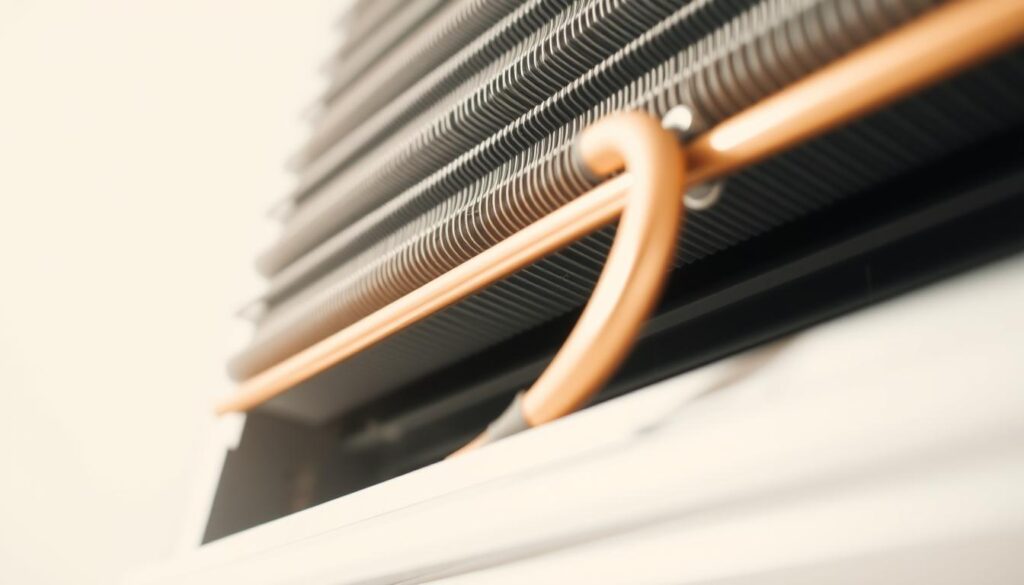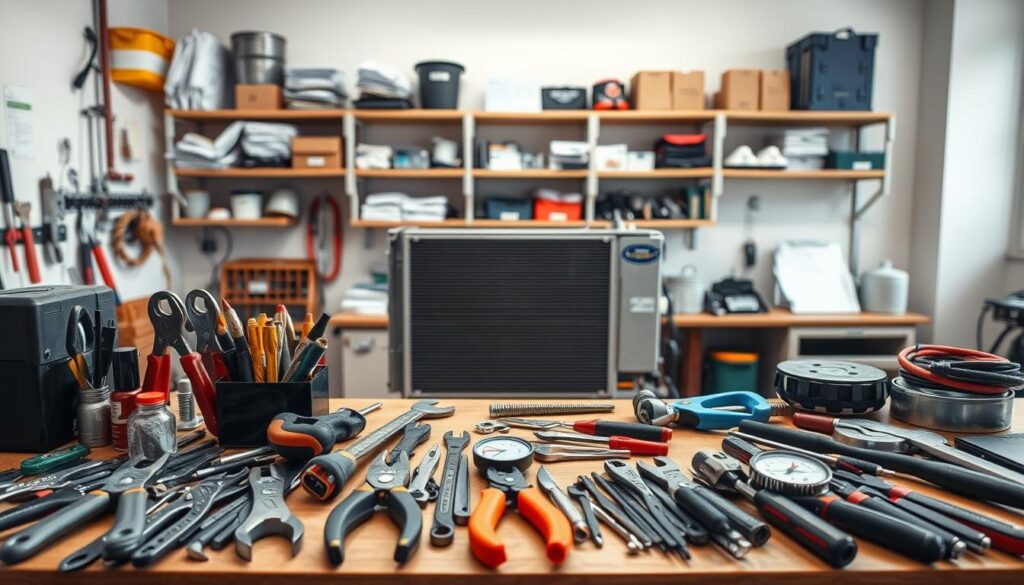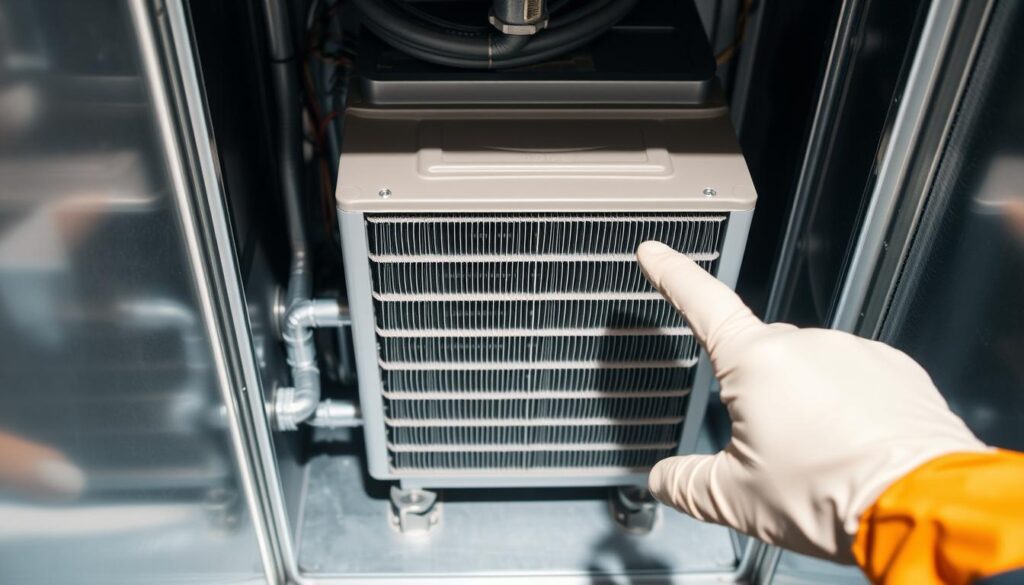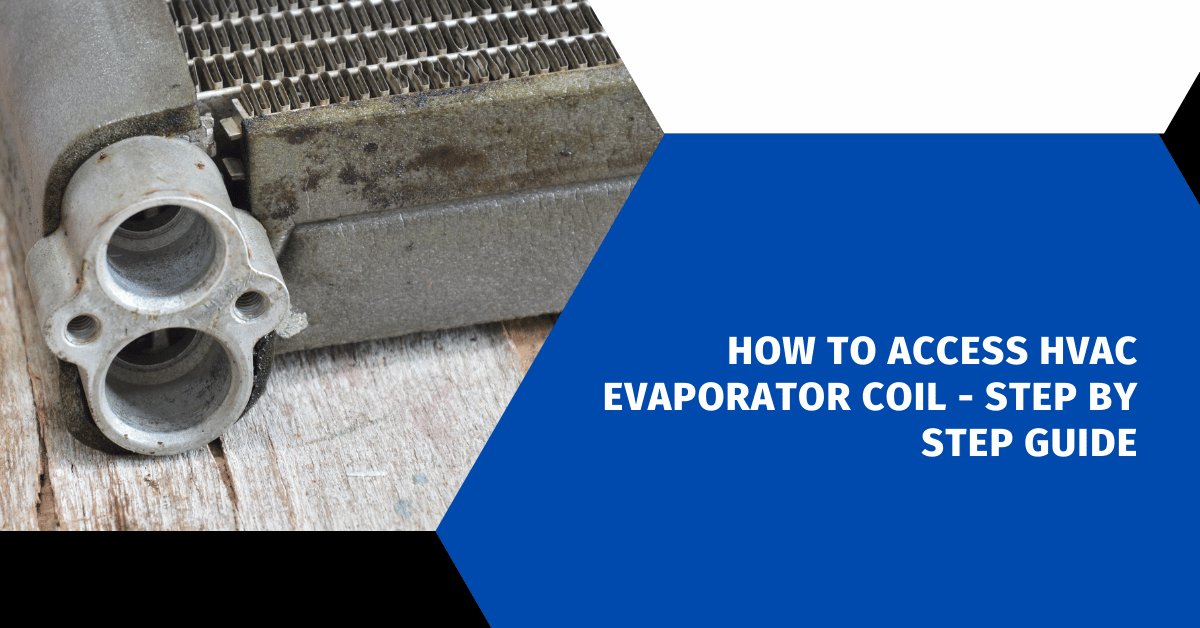Affiliate Disclosure
HVAC Guide Guys is a participant in the Amazon Services LLC Associates Program, an affiliate advertising program designed to provide a means for sites to earn advertising fees by advertising and linking to Amazon.
How to Access HVAC Evaporator Coil? Ever wondered why your AC isn’t cooling like it should? The answer might be in your HVAC’s evaporator coil. Knowing how to access and care for this part can save you a lot of money and make your home more comfortable.

HVAC upkeep is not just for experts. With the right info, you can safely and effectively access your HVAC evaporator coils. This guide will show you how, so you can manage your home’s cooling system better.
Today’s homeowners know that regular HVAC care can make their systems last longer, use less energy, and avoid sudden failures. Whether you love DIY projects or just want to know more about your home’s cooling system, this guide has what you need.
Key Takeaways
- Learn the critical steps to safely access your HVAC evaporator coil
- Understand the importance of regular HVAC maintenance
- Recognize potential signs of evaporator coil problems
- Discover cost-effective maintenance techniques
- Improve your home’s overall cooling efficiency
Table of Contents
Understanding HVAC Evaporator Coils and Their Function
Your HVAC system’s evaporator coil is key to cooling your home. It works quietly to take heat and humidity out of the air. This keeps you cool during the summer.
Evaporator coils are made of copper with aluminum fins. These fins help grab and move heat. They are crucial for fixing HVAC problems and keeping your home cool.
Role in the Air Conditioning Process
The evaporator coil works in a cool way:
- It takes heat from the air inside.
- It changes the refrigerant’s phase.
- It lowers the air’s temperature and humidity.
Impact on System Performance
A clean evaporator coil makes your HVAC system better:
- It cools more efficiently.
- It uses less energy.
- It lasts longer.
Common Issues with Evaporator Coils
| Issue | Potential Consequences |
|---|---|
| Dirt Accumulation | Less efficient heat transfer |
| Frost Formation | Less airflow and strain on the system |
| Refrigerant Leaks | Less cooling |
“Understanding your evaporator coil is key to maintaining a comfortable and efficient home cooling system.” – HVAC Professional
Regular checks and upkeep can stop these problems. This keeps your air conditioning working its best.
Explore Our HVAC Shop
Looking for top-rated HVAC tools, parts, and accessories? Visit our shop and find the perfect solution for your needs.
Visit the ShopEssential Tools and Safety Equipment Required
Getting ready for HVAC evaporator coil maintenance means picking the right tools and following safety rules. You need the correct equipment and know how to use it right.
Experts say you should gather a full toolkit before starting. Here are the key tools you’ll need:
- Screwdriver set with multiple bit types
- Adjustable wrench
- Soft-bristled brush
- Fin comb for straightening damaged coil fins
- Powerful flashlight
- Protective work gloves
- Safety glasses
When working with HVAC systems, safety comes first. Wearing the right protective gear helps avoid injuries and makes maintenance easier.
“Proper preparation prevents poor performance.” – Professional HVAC Maintenance Motto
You’ll also need special cleaning tools:
- Coil cleaner solution
- Mild detergent
- Spray bottle
- Microfiber cloths
Choose high-quality hvac technician tools for better performance. Low-cost tools might seem good at first but can be unsafe and less effective.
Keep in mind, different HVAC systems need different tools. Always check your system’s manual or ask a pro for the right tools.
How to Access HVAC Evaporator Coil
Getting to your HVAC evaporator coil needs careful steps and safety. Knowing how to maintain your HVAC is key. This guide will show you how to safely find and access the evaporator coil.
Locating the Air Handler Unit
The first step is to find the air handler unit. It’s usually in:
- Basement
- Utility closet
- Attic
- Garage
Power Disconnection Steps
When doing HVAC maintenance, safety comes first. Before you get to the evaporator coil, you must turn off the system:
- Turn off the thermostat
- Find the circuit breaker panel
- Switch off the breaker for the HVAC system
- Check that power is off with a voltage tester
Access Panel Removal Technique
To get to the evaporator coil, remove the access panel carefully. Pro tip: Take photos before you start to help with putting it back together. Use the right screwdriver and keep all screws in a safe place.
Always prioritize safety and follow manufacturer guidelines when accessing your HVAC system.
Explore Our HVAC Shop
Looking for top-rated HVAC tools, parts, and accessories? Visit our shop and find the perfect solution for your needs.
Visit the ShopPreparing Your HVAC System for Maintenance
Getting ready for HVAC maintenance is all about planning and detail. Your system’s performance depends on thorough preparation before any service work starts. Regular maintenance can make your cooling system last longer and prevent sudden breakdowns.
Before starting maintenance, make a detailed checklist to ensure you’re ready:
- Check and replace air filters
- Inspect ductwork for potential leaks
- Verify system power connections
- Gather necessary cleaning tools
Replacing filters is key to keeping your HVAC system running well. Dirty filters can cut down airflow and make your system work harder. This can lead to higher energy bills and damage. Experts say to change filters every 30-90 days, based on your home’s environment and how much you use it.
Pro tip: Schedule your HVAC maintenance before the peak cooling season to ensure optimal performance during hot summer months.
Think about your skill level when planning maintenance. Some tasks are perfect for DIY enthusiasts, while others need a pro. If you’re not sure about any maintenance, get a certified HVAC technician. They can give expert advice and check your system thoroughly.
- DIY-friendly tasks:
- Filter replacement
- Basic visual inspections
- Cleaning external components
- Professional maintenance tasks:
- Electrical system checks
- Refrigerant level assessment
- Complex component repairs
By spending time on proper preparation, your HVAC system will run smoothly and efficiently all year.
Initial Inspection and Assessment Procedures
When you’re troubleshooting your HVAC system, checking the evaporator coil first is key. This step helps spot problems early, avoiding big repairs later.
- Look for dirt on the coil
- Check the coil for damage
- See if there’s frost or ice
- Check other parts for wear
Visual Inspection Guidelines
When you inspect, focus on important areas. Spotting issues early can save you money and keep your system running longer.
- Check the coil for dust
- Look for corrosion or metal damage
- Watch for moisture or leaks
- Check the insulation for damage
Identifying Common Problems
Spotting problems early saves time and money. Keep an eye out for these signs:
- Frost on the coil
- Mold or mildew
- Uneven cooling or airflow
- Strange smells when it runs
Documentation Methods
Keeping a record of your HVAC’s health is crucial. Include:
- Inspection date
- Photos of the coil and issues
- Notes and measurements
- Recommended fixes
By following these steps, you can keep your air conditioning in top shape. Catching problems early means fewer big repairs.
Professional HVAC Maintenance Tips

Professional HVAC maintenance is more than just DIY fixes. Experienced HVAC technicians use advanced tools and skills to keep your system running smoothly. They know how to maintain your home’s cooling system at its best.
When choosing a professional HVAC technician, look for certain qualifications:
- NATE (North American Technician Excellence) certification
- At least 5 years of field experience
- Current state licensing
- Good customer reviews and references
Professional maintenance includes detailed checks that homeowners can’t do. Tools like thermal imaging cameras and advanced pressure testers help find small problems early.
Professional HVAC maintenance is an investment in your system’s longevity and performance.
Important professional maintenance services include:
- Thorough system checks
- Accurate refrigerant level checks
- Inspections of electrical connections
- Cleaning of coils with industrial solutions
- Lubrication of moving parts
Regular professional HVAC maintenance keeps your equipment in top shape. It ensures your home stays comfortable all year.
Explore Our HVAC Shop
Looking for top-rated HVAC tools, parts, and accessories? Visit our shop and find the perfect solution for your needs.
Visit the ShopCleaning and Maintenance Techniques
Keeping your evaporator coil clean is key to your HVAC system’s health. It boosts efficiency and extends its life. Regular cleaning stops performance drops and keeps your air clean.
Proper Cleaning Methods
To clean your evaporator coil right, follow these steps:
- First, turn off your HVAC system’s power.
- Then, use a soft-bristled brush to sweep away dirt.
- Next, apply a coil cleaner made for HVAC systems.
- After that, rinse with water, but be careful not to touch electrical parts.
- Finally, let the coils dry completely before putting everything back together.
Recommended Cleaning Solutions
Choosing the right cleaner is important for your HVAC’s upkeep. Here are your options:
- Commercial coil cleaners made just for HVAC systems.
- Mild detergent for a gentle clean.
- Special foam cleaners for tough dirt.
Post-Cleaning Inspection
After cleaning, check your coils carefully to make sure:
- No cleaner is left behind.
- They’re dry.
- No damage happened during cleaning.
- Everything is put back together right.
Experts say to clean your evaporator coils yearly for the best system performance.
By using these cleaning methods, you’ll make your HVAC system work better. You’ll save on energy and make it last longer.
Troubleshooting Common Evaporator Coil Issues

When you’re fixing your HVAC, evaporator coil problems are key. Knowing these common issues helps keep your system running well. It also stops expensive repairs.
Here are some big problems with your HVAC’s evaporator coil:
- Frozen Coils: If air can’t flow well or if there’s not enough refrigerant, ice forms.
- Refrigerant Leaks: These can hurt your system’s performance.
- Dirt and Debris Accumulation: It makes your system work harder to cool.
- Unusual Noises: Sounds like something’s wrong mechanically.
To fix your air conditioning, follow these steps:
- Check if your air filter is clean.
- Look at the refrigerant levels.
- Make sure air is flowing well.
- Listen for odd sounds.
Some issues you can fix yourself. But, if it’s complex, you need a pro. If your cooling isn’t working right or you think your coil is damaged, call a skilled HVAC technician.
Remember: Regular maintenance stops most evaporator coil problems.
Explore Our HVAC Shop
Looking for top-rated HVAC tools, parts, and accessories? Visit our shop and find the perfect solution for your needs.
Visit the ShopPreventive Maintenance Schedule and Best Practices
Keeping your HVAC system in top shape is key for its performance and life span. A good maintenance plan can prevent expensive repairs and keep your home comfy all year.
Creating a detailed maintenance schedule means knowing what your HVAC system needs in each season. Experts say it’s best to be proactive to keep your system in great shape.
Seasonal Maintenance Timeline
- Spring: Do a deep check of your HVAC system
- Check refrigerant levels
- Clean outdoor unit
- Replace filters
- Summer: Focus on cooling system
- Inspect evaporator coils
- Check air flow
- Watch system efficiency
- Fall: Get ready for heating season
- Clean heating parts
- Test thermostat
- Seal air leaks
- Winter: Keep heating system working
- Lubricate parts
- Check heat exchanger
- Make sure insulation is good
Professional vs DIY Maintenance
Some maintenance tasks you can do yourself, but professional HVAC care offers more. Think about these points when choosing DIY or professional help:
- How complex your system is
- Your skill level
- How much time you have
- Warranty needs
Regular maintenance can make your HVAC system last up to 15 years longer and use 20% less energy.
Important point: Regular maintenance and timely filter changes are crucial for your system’s best performance. Whether you do it yourself or hire pros, being proactive saves money and avoids sudden breakdowns.
Conclusion
Keeping your HVAC system’s evaporator coil in good shape is key for top performance and efficiency. By learning how to access your HVAC evaporator coil, you’ve made a big step in protecting your home’s cooling system. Regular maintenance stops costly breakdowns and makes your equipment last longer.
The methods you’ve learned are more than just cleaning. They involve knowing your system’s needs, spotting problems early, and fixing them before they get worse. You can do the maintenance yourself or hire a pro. The important thing is to be consistent and pay close attention to details.
Your HVAC system is an investment in your home’s comfort and energy savings. By following the tips in this guide, you can make your system work better, use less energy, and make your home more comfortable. Remember, getting professional checks can help find problems before they cost a lot to fix.
Start taking care of your HVAC system today. Set up regular maintenance, watch out for any issues, and get help from pros when you need to. Taking good care of your system will bring you comfort, savings, and reliability in the long run.

